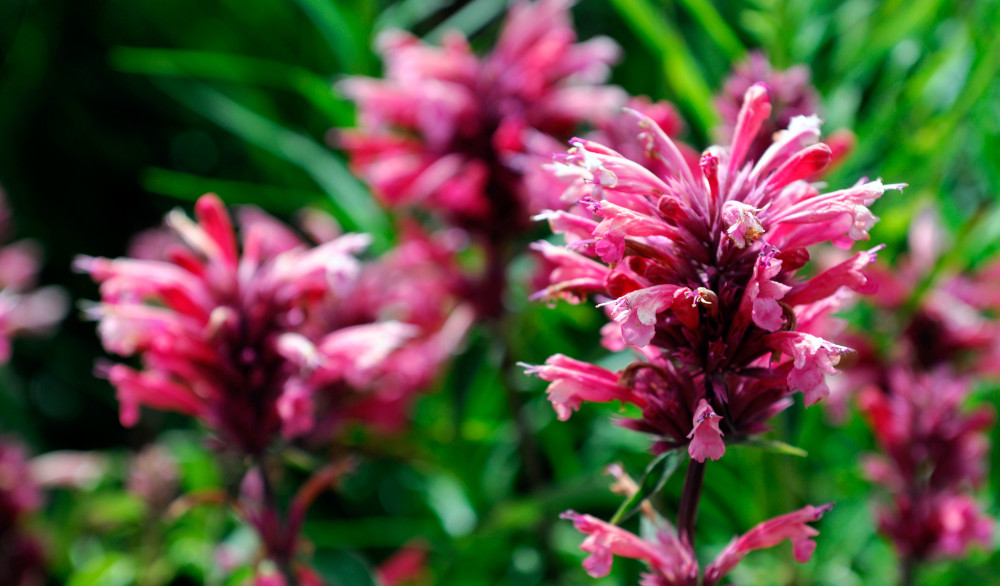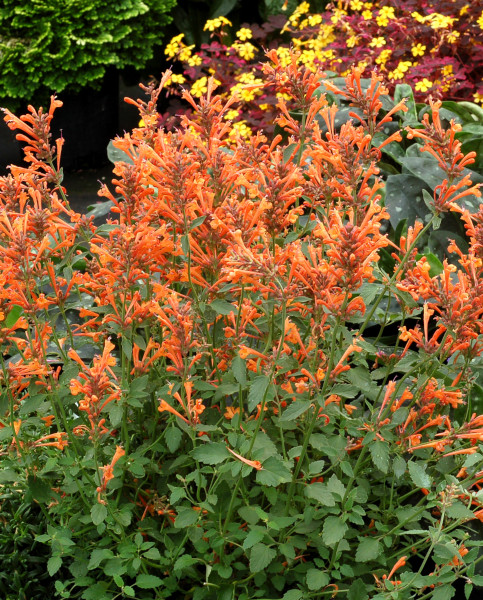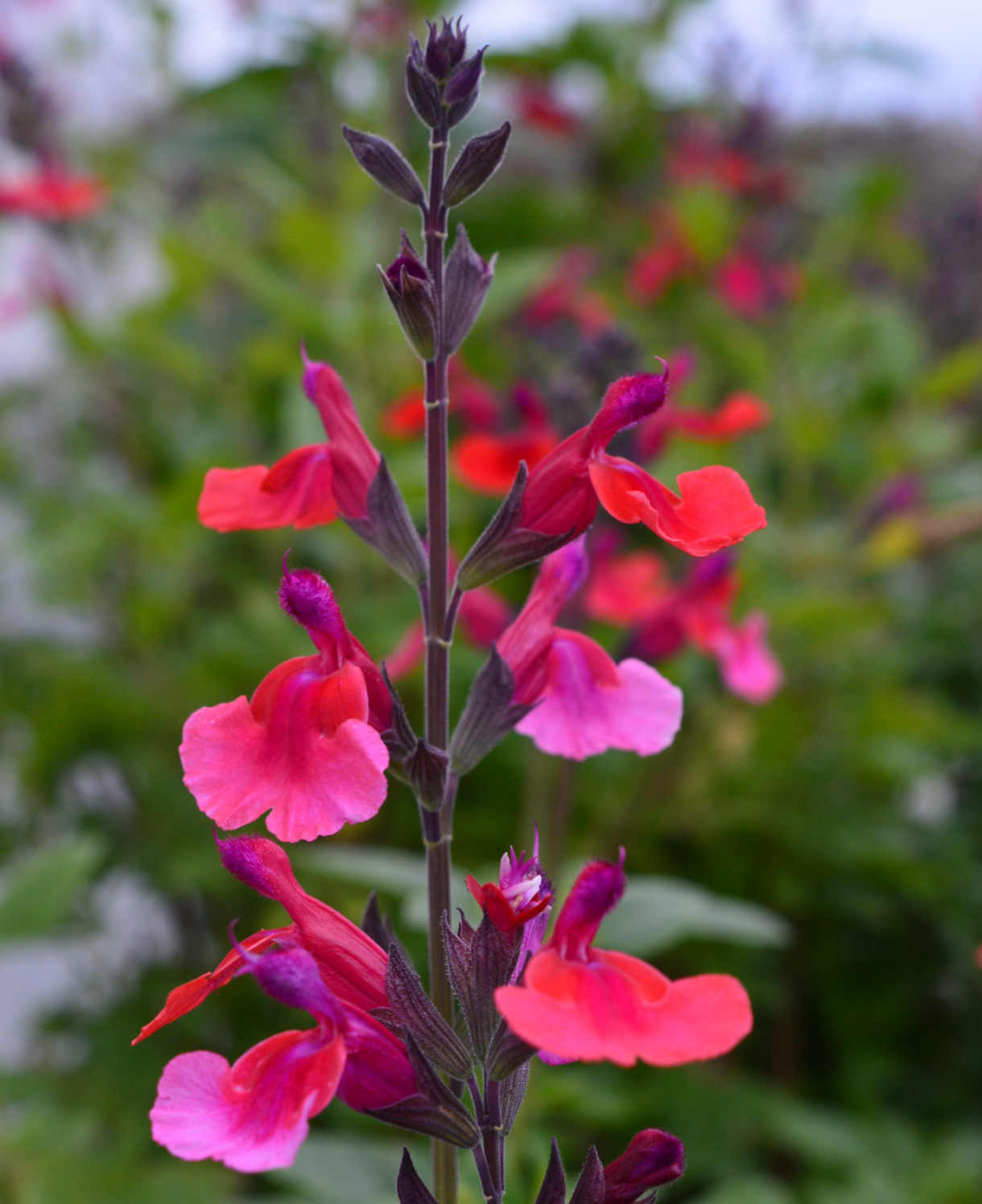How to grow Agastache
A member of the mint family, the genus Agastache is made up of around 30 species of bushy, aromatic perennials, valued for their handsome greyish-green foliage and spikes of whorled tubular flowers. They can be found growing wild throughout China, Japan, USA, and Mexico.
Also known as giant hyssop, Agastache are bushy, aromatic perennials are members of the mint family. Greyish-green leaves emit an unmistakable scent of liquorice and tubular flowers are produced in whorls up tall spikes, usually humming with bees and other pollinators. With a late, long-lasting flowering period, these delicate, colourful plants are invaluable in extending the interest of a planting scheme.
Traditionally, only the blue-flowered Asian and North American species have been hardy enough to grown as perennials in UK gardens, with the more tender and compact red/ orange Mexican species tending to be treated as annuals. (Agastache foeniculum is the exception to this rule, as a blue North American species which is only half-hardy). Recent breeding work, however, has created new Mexican cultivars with increased hardiness and a tolerance for cold, wet soil; meaning they too can now overwinter in our UK gardens.
At Hayloft we offer a wide range of Agastache which includes all the types mentioned above. Read each description carefully to ensure well-informed ordering.

Key Information
Soil pH
Position
Hardiness


Where & when to plant Agastache
Agastache is grown for its for long flowering period, strong aroma, attractiveness to pollinators, and distinctive seed heads which provide a long-lasting source of food for blue tits during winter. It is therefore particularly ideal for use in a wildlife or scent garden, as well as any sunny border or container display.
Hardy varieties
For best results, plant in autumn or spring. An autumn planting is suitable for those gardening in ‘mild’ conditions. (Broadly speaking, this is the southern half of the UK). For those liable to very cold winters or waterlogged ground, it is best to wait until spring. (This is generally the northern half of the UK, or anyone gardening on heavy, clay soil).
Half-hardy varieties
These should be planted in spring, once all risk of frost has passed (this varies across the country though is generally sometime around mid-May).
Agastache require a sunny, well-drained, fertile spot. Adding grit and organic matter to the soil before planting can help achieve optimum conditions.
How to plant Agastache
In the ground
- Clear the chosen area of weeds.
- Dig a planting hole several times larger than the root ball. Now is the time to add a little well-rotted organic matter, and in heavier soils, a generous amount of horticultural grit.
- Place the plant in the hole, ensuring the top of the root ball sits level with the surface of the soil. Too low and the plant may rot, too high and the roots can dry out.
- Backfill with soil and firm in gently.
- Soak well with water.
- Mulch with well-rotted organic matter.
In a container
- Choose an appropriate container, ensuring there are plenty of drainage holes in the bottom.
- It can be a good idea to fill and plant large containers in situ to save yourself the trouble of moving once full.
- Use a good quality potting compost with plenty of horticultural grit mixed in, and, if not already present in the compost (check the description on the bag) some slow-release fertiliser granules.
- Start by partially filling the pot with compost; enough so that when placed on it the upper surface of the root ball is about 3cm lower than the top of the pot.
- Infill all the space surrounding the root ball with compost, firming down with your fingers then adding a little more so the plant is held tight.
- Pick up the pot (if you can!) and lightly tap on the ground a few times to help further settle the compost around the plant.
- Soak well with water.
A mulch with horticultural grit will look attractive and help to prevent a ‘cap’ or crust forming on the top of the compost (something container plants can suffer due to the artificial nature of their watering).

What to plant with Agastache
Agastache mixes easily with a huge range of plants, from those in a busy cottage garden style, to a soft and naturalistic prairie border. To narrow it down slightly, we recommend ensuring you have a range of flower forms and shapes. With agastache fulfilling the vertical accent role, along with, say, digitalis and verbascum, the umbels of orlaya and anthriscus can provide flat platforms. Dahlia and echinacea offer open, daisy-like blooms, while allium and echinops punctuate with their spherical flowerheads. ‘Fillers’ such as geranium, astrantia, oenothera, and thalictrum tie everything together, and grasses such as stipa and miscanthus add movement. Instant designer border!
If you would like any further planting ideas or growing advice for your agastache, please contact our friendly and knowledgeable Customer Care Team - we will be more than happy to help you.



How to care for Agastache
Pruning and Deadheading
Remove spent flower spikes throughout the season.
Try to resist the temptation to cut back until spring, as stems left intact offer protection against winter cold and wet.
Watering
Water until established and then in very dry spells thereafter.
Container-grown agastache will require regular watering throughout the growing season. Allow the top few centimetres of compost to dry out between soakings.
Cold Protection
Tender species (e.g., A. mexicana and A. aurantiaca)
Either treat as an annual (i.e., remove to the compost heap at the end of the growing season), or grow in a container to allow overwintering in a greenhouse or conservatory.
Half-hardy species (e.g., A. foeniculum)
These may overwinter outdoors in a mild, sheltered, well-draining spot. Alternatively, protect with fleece or treat as above.
Hardy species (e.g., A. rugosa, the Kudos series, and several other named cultivars)
These should survive the average UK winter without the need for additional protection, provided they are grown in sunny, well-draining conditions. Even so, give them the best chance possible by delaying pruning until spring (to give crowns extra insulation against cold and wet).
As is the case with all plants, container-grown agastache can be more vulnerable to winter damage than those grown in the ground (even hardy species). It can be worth wrapping pots in hessian or fleece or moving into an unheated greenhouse or conservatory.
Pests and Diseases
Agastache tends to be problem-free, although in very dry summers it may develop mildew on its foliage. Water in very hot, dry spells and mulch generously to avoid such issues.
How to propagate Agastache
Agastache can be propagated by cuttings in late summer.
- Find non-flowering shoots 5-10cm long and snip off the plant.
- Put them in a plastic bag straight away to prevent drying out.
- Fill a container with a compost mix which is at least 50% perlite (or if you prefer, as we do, 100% perlite).
- Remove the lowest third of leaves. If the remaining leaves are large, cut them in half (to reduce water lost through transpiration).
- Insert the cuttings into the compost and water lightly. Several cuttings can be put in the same container if there is enough space to do this without them touching.
- Place in a propagating unit with bottom heat if you have one, or covered with a plastic bag on a windowsill if not (out of direct sunlight).
- Keep the cuttings misted and occasionally watered until they root. You will know this has happened when roots emerge out of the bottom of the container.
- Gently remove rooted cuttings and pot them into individual pots. Grow on in an unheated conservatory or greenhouse they are big enough to be planted out.
Another option is to lift and divide agastache – best done in spring. As well as providing new plants, this also maintains the health and vigour of existing specimens.
- Choose a day when the soil is not frozen or waterlogged.
- Dig the plant out of the ground.
- Shake off any excess soil.
- Separate the plant into sections using either swift, cutting blows with a sharp spade, or two forks inserted back-to-back with tines touching, handles then pushed together to prise the plant apart.
- Discard old, damaged, or surplus pieces, keeping healthy, vigorous material.
- Replant selected pieces where desired.
- Water well until fully established.
Common Agastache Questions
Should agastache be fed?
Too many nutrients can overload agastache, causing it to grow leggy and weak. Agastache in the ground will not need feeding at all (apart from an annual mulch of well-rotted organic matter). Container-grown agastache should have slow-release fertiliser mixed into the potting compost, and apply a weak, liquid feed only if plants show signs of deficiency.
Is agastache easy to grow?
Yes! Providing you understand which type you have (tender, half-hardy, hardy) and follow our cultivation advice accordingly, agastache can be a wonderfully low maintenance and rewarding member of the garden.
What conditions does agastache like?
Give agastache a sunny, well-draining spot and you cannot go far wrong.
Can you grow agastache in shade?
Agastache performs best in a sunny spot. A little light shade may be tolerated, though is likely to result in weaker, less floriferous plants. Full shade is a definite ‘no’.
Can you plant agastache in pots?
Yes, providing you a prepared to water them regularly.
My hardy agastache has started to look sad. What am I doing wrong?
Probably nothing! Even hardy agastache are short-lived perennials, meaning they need to be replaced after around 3-4 years. Propagation by cuttings is easy; getting into a habit of doing this every year or two will mean you never run out of plants and will be popular among fellow gardeners!
Can I use agastache for culinary purposes?
Yes! As a member of the mint and sage family it can be used in much the same way; dried or fresh to add flavour to food and drink.
My agastache has self-seeded in the garden but the new plants do not look the same. What has happened?
If there are any other varieties of agastache planted nearby they are likely to cross pollinate. If you wish to have identical plants, cuttings are the best bet. Otherwise, simply weed out the new versions you do not like and keep those that you do!
Will my agastache require staking?
Grown in the right conditions this should not be necessary. However, if conditions are on the moist, partially shaded side you may experience leggy, floppy growth which will benefit from support.




